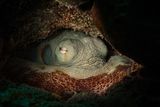Research into the sleeping patterns of the octopus has unveiled intriguing evidence suggesting these creatures may experience a form of dreaming. A study published in the journal Nature highlights that during sleep, octopuses display vibrant color changes, twitching limbs, and rapid breathing, resembling dream-like activity similar to that seen in humans.
To investigate these phenomena, scientists focused on octopus laqueus and monitored their sleep cycles. By gently prodding the animals during both calm and active phases of sleep, researchers established that octopuses required significantly more stimulation to respond when asleep, confirming they were indeed in a sleep state. During this “quiet sleep,” the octopuses appeared white and motionless, punctuated by bursts of activity, known as active sleep, approximately every hour.
Understanding Octopus Brain Activity
The research team, which included experts from the University of Washington, measured brain activity during both sleep and wakefulness. They discovered that during quiet sleep, octopuses exhibited neural activity patterns resembling mammalian “sleep spindles.” While the exact role of these spindles remains unclear, researchers believe they play a crucial role in memory consolidation.
Approximately once every hour, each octopus entered a one-minute phase of activity characterized by neural patterns similar to those seen when the animals were awake. Leenoy Meshulam, a statistical physicist involved in the study, noted, “The fact that two-stage sleep has independently evolved in distantly related creatures, like octopuses, suggests that possessing an active, wake-like stage may be a general feature of complex cognition.”
Visual Indicators of Dreaming?
One of the most remarkable aspects of octopuses is their ability to change skin color and texture. This ability, controlled by specialized pigmented skin cells, is used for camouflage and communication. To observe these changes during sleep, the research team filmed the octopuses in ultra-high 8k resolution.
Meshulam explained, “By filming in such high resolution, we can see how each individual pigmented cell behaves in order to create an overall skin pattern.” Unexpectedly, the footage revealed that octopuses cycled through skin patterns during active sleep that mirrored those seen when they were awake, hinting at a possible dreaming process influencing their color changes.
The researchers propose that this skin patterning could indicate the octopuses are rehearsing camouflage techniques or reliving experiences from their day, such as avoiding predators or hunting prey. Sam Reiter, a senior author of the study, remarked, “While humans can verbally report what kind of dreams they had, the octopus’ skin pattern acts as a visual readout of their brain activity during sleep.”
The findings suggest that complex sleep, complete with a phase akin to REM sleep, may not be exclusive to mammals and has evolved in surprising ways across different species. This research opens avenues for understanding the cognitive capabilities of cephalopods and their unique forms of consciousness.
As scientists continue to explore the mysteries of octopus behavior and cognition, this study paves the way for further inquiry into the depths of animal consciousness and the nature of dreaming across species.






































































